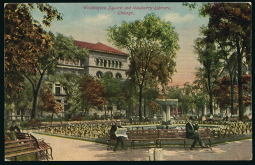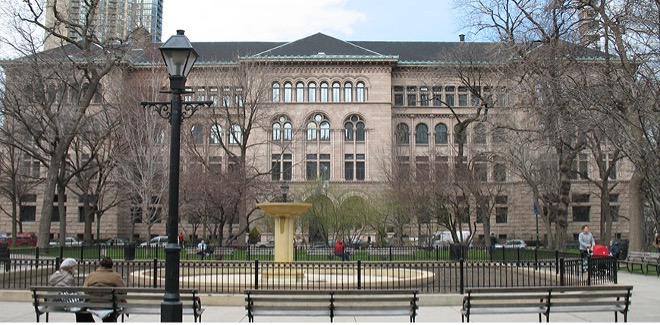Bughouse Square (Washington Square Park)

Washington Square Park postcard, undated.
901 N Clark St, Chicago, IL 60610
In 1842, Orasmua Bushnell and American Land Company donated three acres of land to be used for used as Chicago’s first park. At the time, the area, essentially a cow path and watering well, was an underdeveloped outpost of the city. As hoped, the park attracted new housing and churches, ostensibly contracted by American Land Company. In the 1860s Mahlon D. Ogden, brother of Chicago’s first mayor, William B. Ogden, was one of those who erected a palatial home in the area, on the same spot where the Newberry Library would be built in the 1890s. The brothers were also among the 12 founding members of the Chicago Historical Society.
Nearly three decades after the park was first developed, the city added trees, flowerbeds, and sidewalks. More than two decades after that, in 1890, it spent $2,000 to construct a fountain at the center of the park. Five years later, the city footed the same amount of money to refurbish the fountain. Five years after that, the city decided the fountain’s maintenance and upkeep was prohibitive and replaced the fountain with more flower beds. It took until 1906 to bring back a fountain, as part of a bigger facelift.
Though the newly renovated park was an attractive green space, the neighborhood around it began to change in the early 20th century. Mansions on surrounding blocks were converted to flophouses, and vagrants increasingly took up transient residence in the park, chasing away a lot of the well-scrubbed patrons, including families. Into this environment, in about the early 1910s, came the soapboxers. “Soapboxers” was a term for orators who stood atop soap boxes in the park to shout or preach or deliver ideas ranging from politics to philosophy to current events. Prohibition, women’s rights, free love…no topic was off limits. With Washington Square Park in the shadows of the erudite and respected Newberry, the park attracted a host of intellectuals, Bohemians, and radicals, amongst them many writers whose esoteric work had a better chance to find an audience there than in print. Some were metaphorically nuts while others were literally insane, which is where the term “Bughouse Square” derives—slang for a mental health facility. Soon, crowds began gathering to hear the “crazies.”
In a 1964 Chicago Daily News piece, Slim Brundage, a regular orator, said, “If anyone had anything to say at the Bug Club, he just stood on the grass and started yakking. If he said it well, he had a tremendous audience. If he was a rank tyro, as I was in those days, he still got a kindly few souls to listen. Sometimes there would be three or four big meetings going on a pleasant Sunday afternoon, with 3,000 getting free entertainment. Besides the big gatherings, there were ‘beehives,’ which were just arguments people clustered together to listen to.”
These gatherings happened primarily on warm-weather evenings, and lasted through the mid-1960s. According to Franklin Rosemont, writing for Encyclopedia of Chicago, “In its heyday during the 1920s and 1930s, poets, religionists, and cranks addressed the crowds, but the mainstays were soapboxers from the revolutionary left, especially from the Industrial Workers of the World (IWW), the Proletarian Party, Revolutionary Workers' League, and more ephemeral groups. Many speakers became legendary, including anarchist Lucy Parsons, ‘clap doctor’ Ben Reitman, labor-wars veteran John Loughman, socialist Frank Midney, feminist-Marxist Martha Biegler, Frederick Wilkesbarr (‘The Sirfessor’), Herbert Shaw (the ‘Cosmic Kid’), the Sheridan twins (Jack and Jimmy), and one-armed ‘Cholly’ Wendorf.” Other figures of the early 20th century included patrons of forums and gatherings at places like the Dill Pickle Club on the east side of the square, where they would discuss the social issues of the day. Social activists, scholars, and literary figures like Sherwood Anderson, Carl Sandburg, Theodore Dreiser, Ben Hecht, Kenneth Rexroth, and Upton Sinclair, joined founder John A. Jones, Jim Larkin, and Ben Reitman, among others, to promote activism and the arts in Chicago.
Studs Terkel, Chicago’s legendary oral historian and storyteller, and an inaugural inductee into the Chicago Literary Hall of Fame in 2010, was a part of those crowds in the so-called heyday. This was long before he wrote his first best-selling book at age 55, in 1967. From 1926 to 1936 the Terkel family ran a rooming house, the Wells-Grand Hotel at 533 North Wells Street, a short walk from the Newberry Library and Bughouse Square. Polly Fletcher at the Newberry Library introduced Terkel to Chicago classics, like Upton Sinclair’s The Jungle and Theodore Dreiser’s Sister Carrie. Terkel stumbled across the orators in Bughouse Square, and later credited his knowledge of the world to the people who congregated there, as well as the tenants who gathered in the lobby of his family’s hotel.
In the Chicago History Museum’s Conversations with America, Terkel says, “Old Man Newberry in offering a library to the city insisted on a proviso: the square on which it stands shall be dedicated to free speech, any kind of speech. On a given spring, summer, or fall evening as many as five soap boxes feature impassioned men, and, occasionally, an impassioned woman. I’m told Emma Goldman once held forth here. Just last month, in this year, 1926, I heard Lucy Parsons. She’s the widow of Albert, one of the Haymarket martyrs. This feisty old lady. Forty years before, she’d become a young widow, as Albert Parsons the bonny one walked to the gallows singing ‘Annie Laurie.” It was an eight-hour day these troublemakers had in mind. She is shabbily dressed. And yet there’s something eloquent about her. Years later, at Lucy Parsons funeral, Win Stracke sang. It was ‘Joe Hill’ rather than ‘Annie Laurie.” At the end of each speech, the hat is passed around, no matter what the cause. I see nickels and dimes and occasional quarters, as well as pennies. I saw Sprague shove a dollar into the hat after Lucy’s speech. Sprague lives on practically nothing. He dines on graveyard stew every night at Victoria Number Two. No teeth. McPherson tells me that Sprague was badly beaten up some years before in Seattle by vigilantes, and he hasn’t been the same since. But I saw him shove that buck surreptitiously into Lucy’s flowered hat.”
Terkel asked to have his ashes scattered in Bughouse Square, and that was the premise of the Theater and Performance Studies at the University of Chicago ‘s Buried in Bughouse Square: A Studs Terkel Circus,” which was a theatrical performance at the Logan Arts Center in 2016. This play was part of a festival called Let’s Get Working that celebrated Terkel.
At the height of the Square’s popularity, many of the soapboxers built enough of a reputation and following that their pass-the-hat earnings, when pooled together, allowed them to rent a run-down apartment during the winter months. But anti-Communist sentiment during the Joseph McCarthy “Red Scare” years quickened the end of the soapboxing tradition. By the mid-to-late 1940s, public outrage against the orators, which included frequent letters and opinion pieces in local newspapers, was so strong that speakers, one by one, stopped coming to the square. As alcoholics and homeless people took their place, Washington Square Park became known as a dangerous place, especially after dark, when homosexuals and prostitutes used it as a central meeting spot. Adult movie theaters and book shops cropped up all around the park. But, in accordance to its liberal atmosphere and acceptance of free speech, Chicago's first ever Gay Pride Parade originated in the park in 1970.
Bughouse Square’s revival began in the 1980s, when Mayor Byrne planted a ceremonious plant at a press conference announcing major residential development in the area. A police crackdown followed, and soon the park transitioned to what it is today: a lovely, pristine green space in an area populated by relatively affluent singles and families. In 1986, the Newberry revived the Bughouse Square debates to celebrate free speech. It is held on the last Saturday in July, and has been held every year, other than during the 2020-21 health pandemic, since. The festivities include the Open Soapbox, the judged The Soapbox Debates, the curated The Main Debate, and a presentation to the winner of the John Peter Altgeld Freedom of Speech Award. In his later years, Terkel spoke at the event many times, and Chicago Tribune reporter and WGN radio personality Rick Kogan often emcees the festivities.
In 1996, the Newberry Library replaced a plaque on the existing stone table in the southwest corner of the park in order to acknowledge the historical significance of Bughouse Square. With the participation of the Chicago Park District, the new plaque, still there now, reads, “Washington Square Park 1842 Chicago’s Premier Free Speech Forum Re-Dedicated July 27, 1996.”

Newberry Library and Washington Square Park








